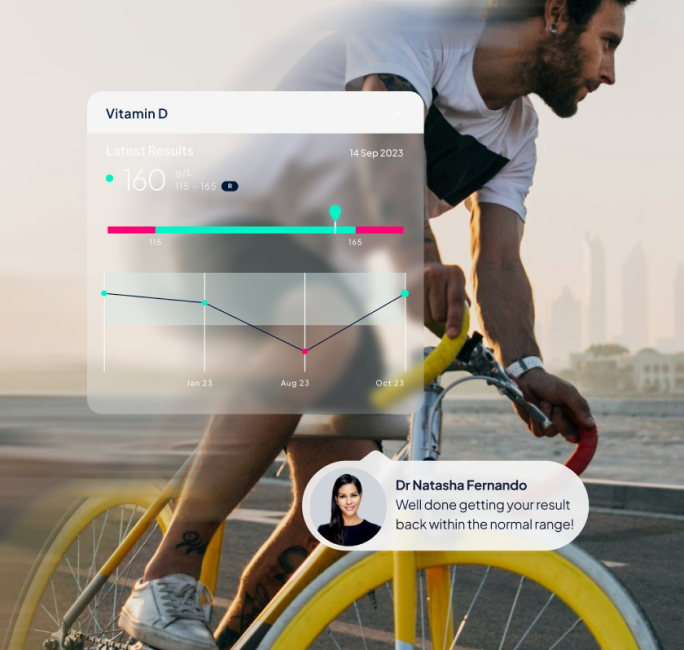This routine health check provides a comprehensive look at your overall well-being, making it ideal for general health monitoring. It covers a wide range of biomarkers to assess organ function, nutritional balance, and potential health risks. Whether you’re looking for peace of mind or early detection of issues, this test offers valuable insights.

Go beyond the numbers
Get ready to elevate your health understanding with a personalised doctor's report. Go beyond results and tap into expert insights tailored just for you.
- Actionable advice
- Expert support
- Tailored recommendations

How it works
You have the flexibility to choose what works best for you. Enjoy the comfort of having a friendly nurse visit your home for a quick blood draw, opt for a convenient visit to one of our nationwide partner clinics, or self-arrange a draw at a location that suits you.
Take control of your health with Medichecks – order your blood test today!

Track, improve, and monitor your health over time.
MyMedichecks is your personal online dashboard where you can view your results, access clear and simple explanations about individual health markers, monitor changes in your health, and securely store information about your medical history, lifestyle and vital statistics.
What's in the test?
Cholesterol status
Total cholesterol
Learn more
LDL cholesterol
Learn more
Non-HDL cholesterol
Learn more
HDL cholesterol
Learn more
Total cholesterol : HDL
Learn more
Triglycerides
Learn more
Clotting status
Platelet count
Learn more
MPV
Learn more
Diabetes
HbA1c
Learn more
A raised HbA1c result points to diabetes or an increased risk of developing diabetes, which can have a significant impact on your lifespan and quality of life. Complications of uncontrolled diabetes include heart disease, kidney disease, eye problems, and vascular conditions. It can also contribute to mental health problems. And men with diabetes are three times more likely to have erectile dysfunction. Keeping your HbA1c within a normal range can help you reduce the risk of these conditions.
Gout risk
Uric acid
Learn more
Inflammation
hs-CRP
Learn more
Iron status
Iron
Learn more
TIBC
Learn more
Transferrin saturation
Learn more
Ferritin
Learn more
Kidney health
Urea
Learn more
Creatinine
Learn more
eGFR
Learn more
Liver health
Bilirubin
Learn more
ALP
Learn more
ALT
Learn more
Gamma GT
Learn more
Proteins
Total protein
Learn more
Albumin
Learn more
Globulin
Learn more
Red blood cells
Haemoglobin
Learn more
Haematocrit
Learn more
Red cell count
Learn more
MCV
Learn more
MCH
Learn more
MCHC
Learn more
RDW
Learn more
White blood cells
White cell count
Learn more
Neutrophils
Learn more
Lymphocytes
Learn more
Monocytes
Learn more
Eosinophils
Learn more
Basophils
Learn more
How to prepare for your test
Prepare for your Essential Blood Test by following these instructions.
Sample collection and timing
- Take this test when any symptoms of short-term illness have settled.
- Avoid heavy exercise for 48 hours beforehand.
Fasting and hydration
- Avoid fatty foods for eight hours before your test, you do not need to fast.
- Stay well hydrated before your test.
Medications and supplements
- Do not take biotin supplements for two days before this test, discuss this with your doctor if it is prescribed.
Test limitations
Reviews
FAQs
What can I learn from this test?
Our essential profile contains many of the tests your doctor would order. We've carefully selected these markers to give you insights into your health and well-being. We've included standard haematology and biochemistry profiles to cover your bodily systems, including a full blood count (FBC), kidney function, liver health, cholesterol, diabetes, iron status, and inflammation (CRP).
Who is this test for?
With your results, this test allows you to optimise health factors that you can change through diet and lifestyle, meaning that you can be proactive about your health. It's also helpful if you're experiencing general symptoms and would like a routine blood test to investigate them.
What is the Essential Blood Test?
Our Essential Blood Test is a comprehensive, quick, and reassuring way of assessing your current state of health.








